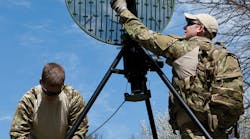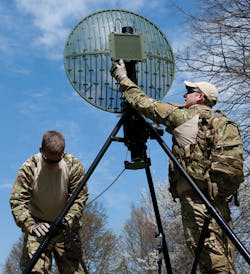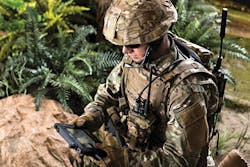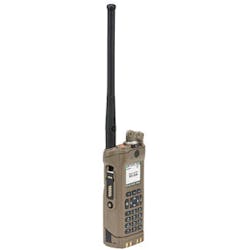This file type includes high resolution graphics and schematics when applicable.
Military electronics is a broad term encompassing thousands of different technologies, from secure communications to x-ray systems. Microwave and RF components and subsystems have played key roles in military electronic designs since the birth of radar systems during World War II. As modern military electronics extend from unmanned ground vehicles (UGVs) and unmanned aerial vehicles (UAVs) and directed-energy weapons to ground-based radio systems and communications satellites in space, microwave and RF technologies expand with them in many shapes and sizes.
Related Articles
• Radar Systems Scan The Skies
• Charging Mats Wirelessly Power Military Devices
• Radar Continues Scanning Outward
Communications is still one of the most critical sectors of military electronics, and a great deal of battlefield communications still relies on traditional tactical radios. While their physical appearances have not changed much over the past two decades, these radios have evolved a great deal in terms of modulation, encryption, and security. As with wireless communications in other applications, a trend in the design of these tactical radios has been towards increased bandwidth operation and the use of multiple bands within a single unit.
For example, Harris Corp. has enhanced its Falcon III® tactical radios over the years, constantly improving performance and usefulness. The company’s Falcon III AN/PRC-152A multiband handheld radio recently earned Joint Tactical Radio System (JTRS) certification from the Joint Tactical Networking Center, a certifying agent of software-defined-radio (SDR) knowledge for the United States Department of Defense (DoD). This is the second Harris Falcon III wideband radio to receive this designation, following the AN/PRC-117G multiband manpack radio.
JTRS is a DoD program to develop SDRs for sending and receiving voice, data, and video tactical communications on the battlefield. The JTRS certification for the Falcon III AN/PRC-152A is a sign that the radio is approved and ready for battlefield networking. It has been designated as a low-risk option and highly interoperable with other approved tactical radios. The radio was certified using Soldier Radio Waveform software version 1.01.1C. According to George Helm, President of the DoD business unit for Harris RF Communications, “JTRS certification means our radios meet the stringent DoD requirements for wideband tactical communications, and perform to common government standards for interoperability, security, and software re-use.”
As in the commercial world, the demand for more data and communications systems capable of providing faster data rates also continues to grow on the battlefield. To meet that demand, Harris has developed what it is calling its “next-generation” Falcon III RF-7800W-OU-500 High Capacity Line-of-Sight (HCLOS) tactical radio (Fig. 1). It is building on the firm’s current RF-7800W-OU440 HCLOS radio's technology. The new radio, which uses multiple-input, multiple-output (MIMO) technology, can run 64-state quadrature-amplitude modulation (64QAM) and provide better than 180 Mb/s Ethernet throughput speeds. The radio is designed for secure, reliable long-range connectivity at distances beyond 160 km. It operates over an extended frequency range (4.40 to 5.875 GHz) and operates in point-to-point (PTP) and point-to-multipoint (PTM) modes.
The secure Federal Information Processing Standards (FIPS) 140-2 Level 2 compliant design includes 256-b Advanced Encryption Standard (AES) protection. In addition, the radio incorporates Harris’s proprietary Traffic Flow Security (TFS) encryption, Enhanced Interference Mitigation (EIM), and data smoothing. The lightweight radio weighs only 5.5 lbs and can be deployed in minutes, with seamless integration of video, voice, and sensor systems.
Harris has also developed lower-cost radio technology for the warfighter in the form of its RF-330E-TR Wideband Team Radio (Fig. 2). Suitable for communication of secret-level information, the wideband radio represents the first fielding of the company’s Embedded Modular Radio (EMR) technology. It allows users to share and access Type-1 secret information while maintaining the logistical benefits of a non-controlled-cryptographic-item (non-CCI) radio. The battery life is estimated at 20 h, ideal for long missions. The light-weight radios can provide simultaneous voice, high-speed data, and up-to-date position location information (with built-in GPS receiver), with the ease of use of a dashboard display that shows battery life and network status at the push of a button.
Motorola has developed its SRX 2200 Combat Radio to meet military performance requirements (even operating while submerged under water) while providing secure, encrypted communications (Fig. 3). It also offers a variety of “convenience” features, including radio-to-radio text messaging, tactical radio inhibit and night-vision goggle compatibility, and Individual Location Information (ILI) to provide details on a radio’s location. The radio is compliant with DoD standards for APCO waveforms and encryption and meets Federal Information Processing Standard (FIPS) 140-2 Level 3 security for secure voice and data communications.
SDRs And More
Software-defined radios (SDRs) have experienced increased use in military applications for secure communications, but these radios have also been embraced by a growing number of commercial customers, including for amateur (ham) radio use. Typically based on a personal computer (PC) in some form, an SDR typically employs spread-spectrum and ultrawideband techniques for security and to allow multiple radios to operate in the same location without interference. SDRs are also known as cognitive radios, where each radio measures available spectrum in an area and communicates that information to other SDRs within range.
JTRS has supported the use of SDR technology for military applications via the Software Communications Architecture (SCA) standard, which promotes the development of interoperable software modules based on accepted operating systems, to “define” the radios for different functions and applications. Commercial radio vendors also refer to the SCA for use in civilian radios for mass market applications. Although based on software to define their waveforms, SDRs still rely on increased functionality and affordability of the system-on-chip (SoC) devices within the radios, to provide microprocessor and digital-signal-processing (DSP) capabilities, for these radios to achieve wider-spread acceptance in commercial and military applications. It should be noted, however, that both variants of tactical radios and radios based on SDR technology have been gaining ground in public safety markets.
While these different radios support short-range communications, military customers still look to the skies (notably satellites) for longer-range communications. For example, Boeing and the US Air Force recently launched their sixth Wideband Global Satcom satellite, WGS-6, as part of the growing WGS communications network for the DoD and its international partners (Fig. 4). As Craig Cooning, Vice President and General Manager of Boeing Space & Intelligence Systems, notes, “The demand for wideband satellite communications continues to increase. WGS-6 and the additional WGS spacecraft yet to be launched will help to meet that need.” Earlier in the year, the firm launched WGS-5 as part of building this wideband military satcom system. The satellites provide secure X- and Ka-band communications using shaped and steerable spot beams that can be readily reconfigured.
Aside from launching military communications satellites, Boeing has been busy developing other electronic technologies for the military, such as high-energy lasers. Working as part of the DoD’s Robust Electric Laser Initiative (RELI) effort, Boeing recently demonstrated the latest capabilities of its Thin Disk Laser system, a solid-state laser system capable of better than 30 kW output power, or almost 30% more power than defined by RELI requirements (Fig. 5). Such directed-energy weapons can pinpoint a laser beam to destroy or disable a target with little or no collateral damage.
According to Michael Rinn, Vice President and Program Director for Boeing Directed Energy Systems, “In order to be truly viable as a weapons-class system, a laser must achieve high brightness while simultaneously remaining efficient at higher power. Our team has shown that we have the necessary power, the beam quality, and the efficiency to deliver such a system to the battlefield.” These demonstrations marked the first time the company has simultaneously achieved high beam quality at high power levels.
Back in space, Lockheed Martin, working with the US Navy’s Aegis Combat System, has completed its first live firing test to show that the system can defend beyond line of sight by integrating data from remote sensors to intercept a target. This was the first test at sea of the Naval Integrated Fire Control-Counter Air (NIFC-CA) capabilities of the Aegis system. By employing functionality known as Cooperative Engagement Capability (CEC) to interpret data from remote sensors, the Aegis system was able to launch a Standard Missile-6 (SM-6) missile from the USS Chancellorsville (CG-62) to intercept a target.
Jim Sheridan, Director of US Navy Aegis programs for Lockheed Martin, remarks: “The latest NIFC-CA test demonstrated how the Aegis Combat System has taken a significant step forward in increasing interoperability with remote systems to extend the distance that we can detect, analyze, and intercept targets.”The upgrades to Aegis systems on cruisers and destroyers are based on commercial-off-the-shelf (COTS) components to reduce costs.
Lockheed Martin has also been busy improving radar technology, thanks to $206 million in additional orders from the US Army for the AN/TPQ-53 (Q-53) long-range counterfire radar system. This radar system is designed to provide enhanced 360-deg. detection and protection from indirect fire. The company has so far delivered 32 systems to the US Army, with an additional 33 systems in production. This latest contract covers an additional 19 Q-53 systems. Mounted on a five-ton truck, the Q-53 can be rapidly deployed, automatically leveled, and remotely operated with a laptop computer or from a fully equipped climate-controlled command vehicle. The system provides 360-deg. capability to detect, classify, and track incoming motars, artillery, and rockets at distances to 20 km (to 60 km when operating in a 90-deg. search mode), is relatively easy to operate, and easy to transport.
Related Articles
• Radar Systems Scan The Skies
• Charging Mats Wirelessly Power Military Devices
• Radar Continues Scanning Outward
In terms of future communications needs, US military researchers at the Defense Advanced Research Projects Agency (DARPA) are well aware of rapidly increasing requirements for handling more data at higher speeds, and are hoping to develop a military wireless data link that can transmit data at rates exceeding 100 Gb/s per radio channel. The research efforts are being conducted within the DARPA 100 Gb/s RF Backbone (100G) program. In support of this work, several contracts were recently awarded to Silvus Technologies and Trex Enterprises Corp. for work on the program. The contracts were awarded by the US Air Force Research Laboratory at Wright-Patterson Air Force Base on behalf of DARPA. The two companies join Applied Communication Sciences, already on the 100G program.
The goal of the 100G program is to establish an airborne communications link with the capabilities of the fastest ground-based fiber-optic communications systems, with the capabilities to operate effectively through clouds, rain, and fog. The companies will seek spectral efficiencies of better than 20 b/s/Hz for wireless data speeds of 100 Gb/s at ranges to 125 miles for air-to-air links and to 62 miles for air-to-ground links, assuming aircraft at about 60,000 ft. altitude.
This file type includes high resolution graphics and schematics when applicable.






